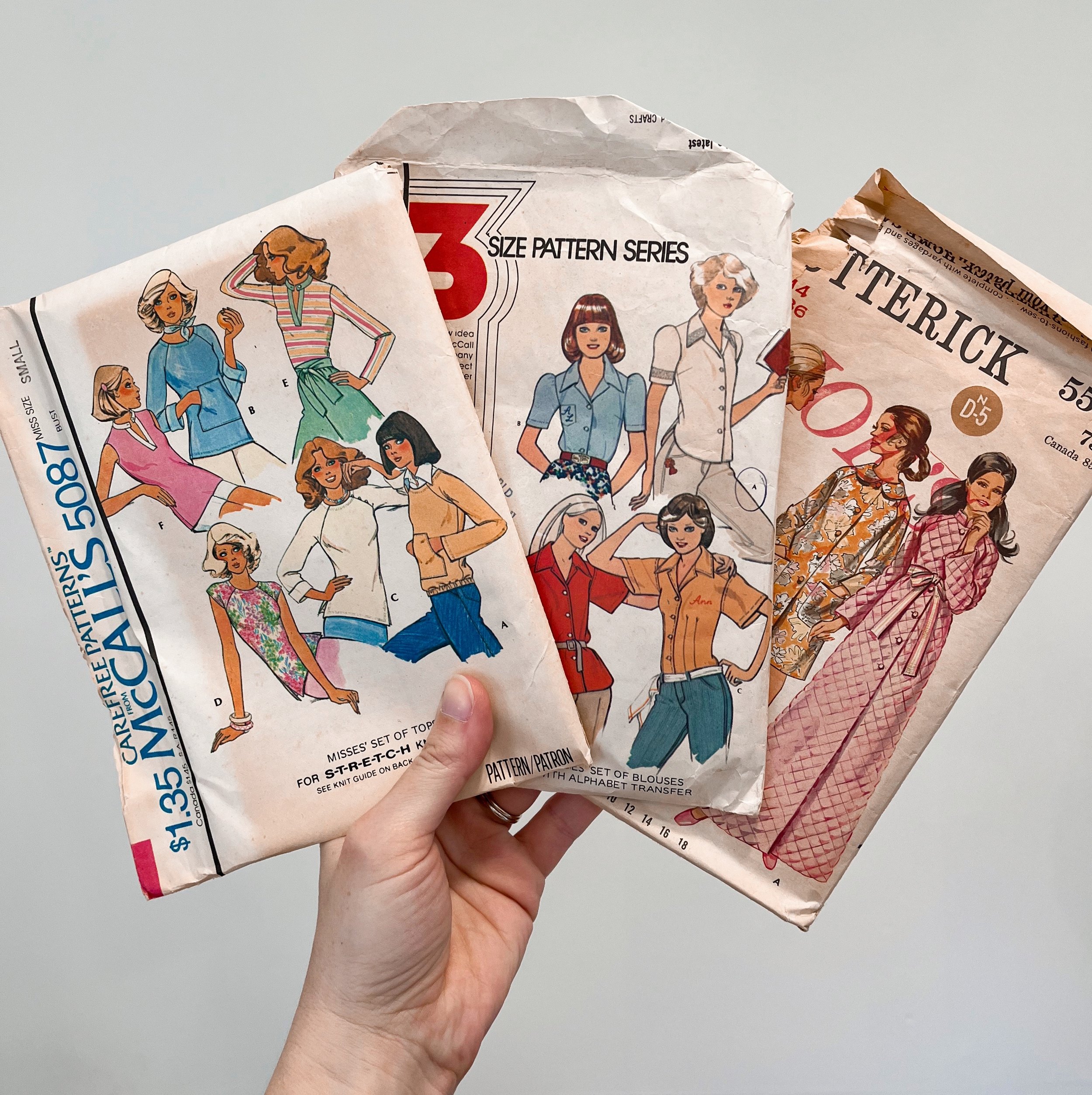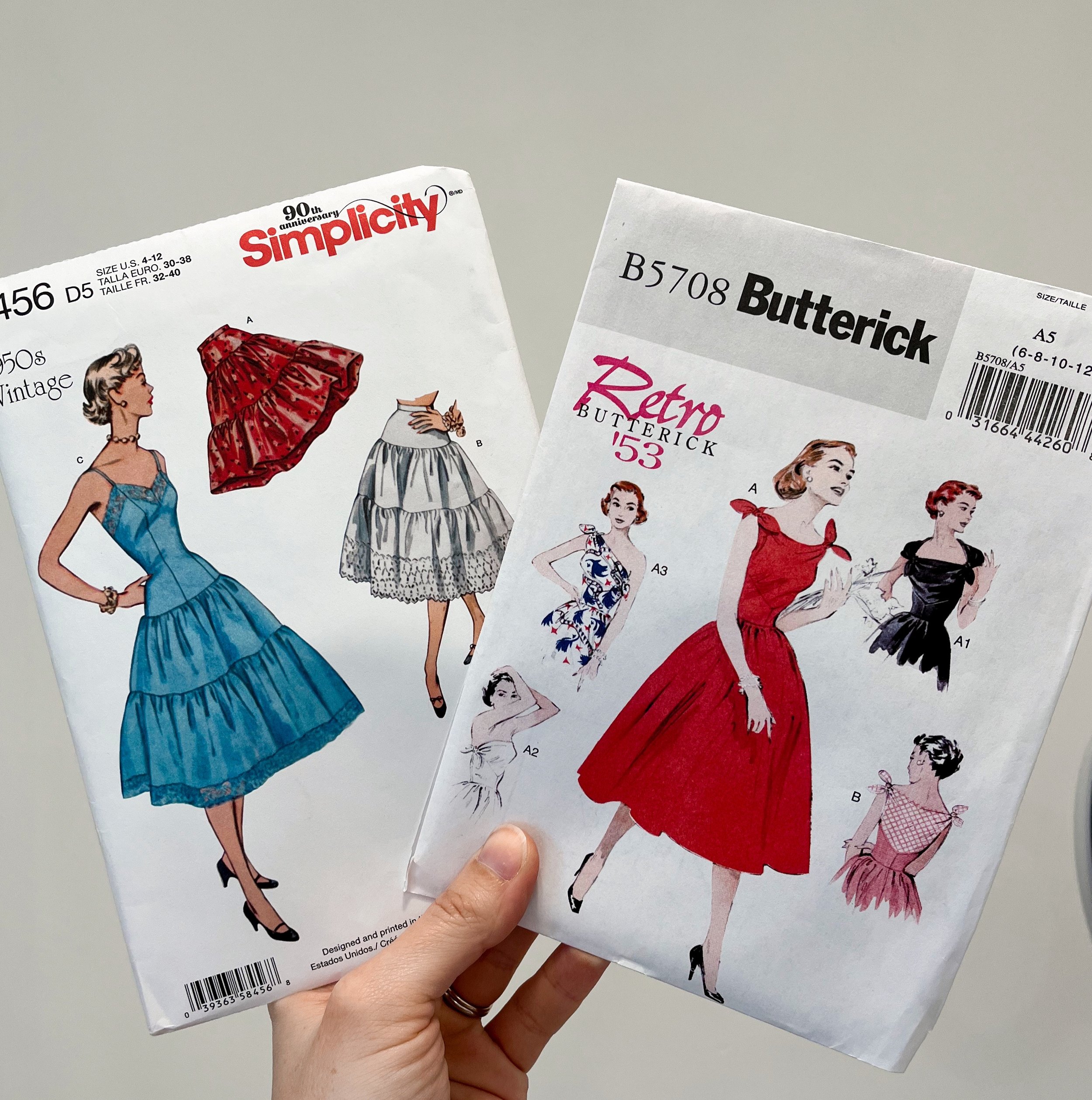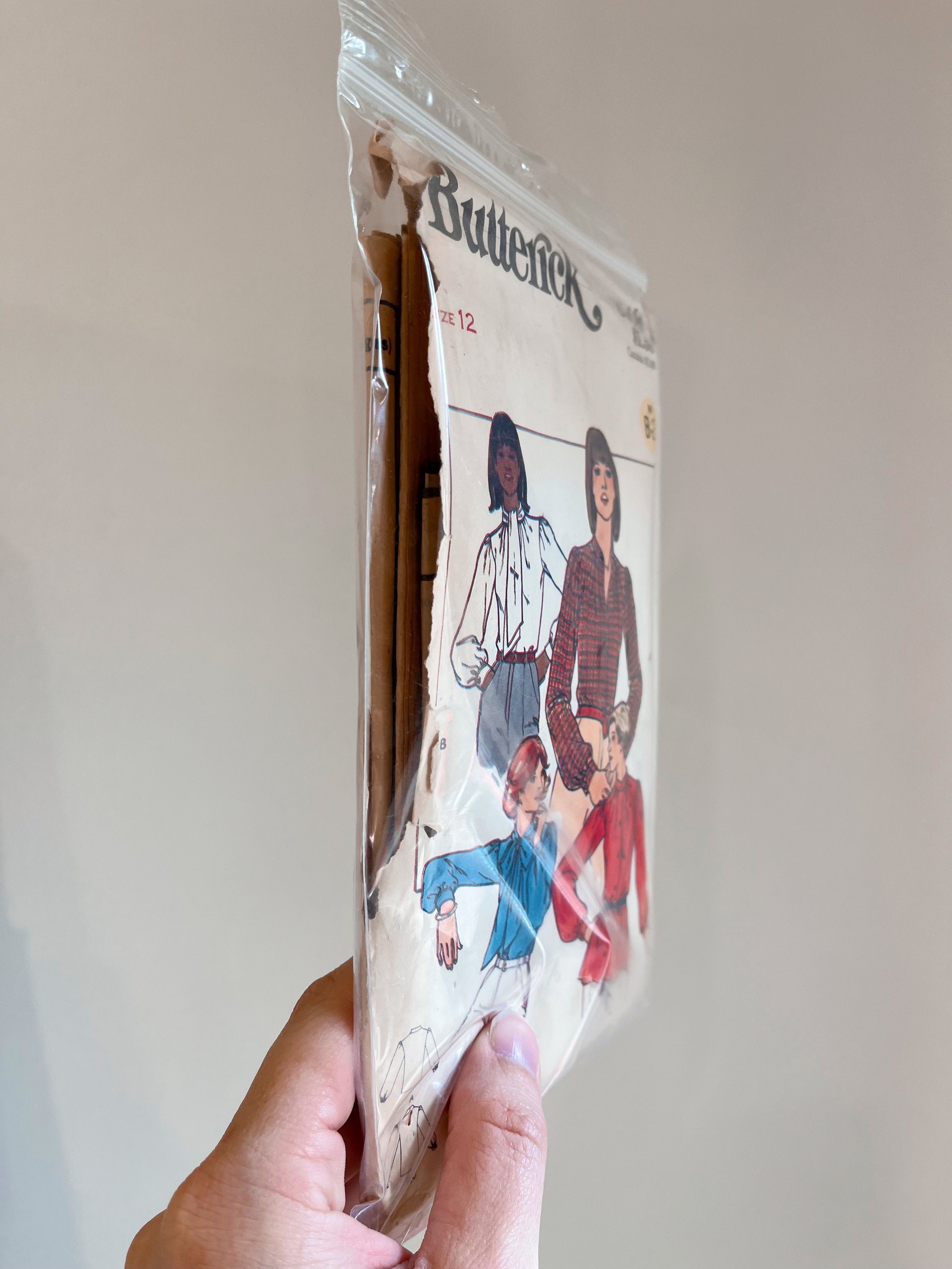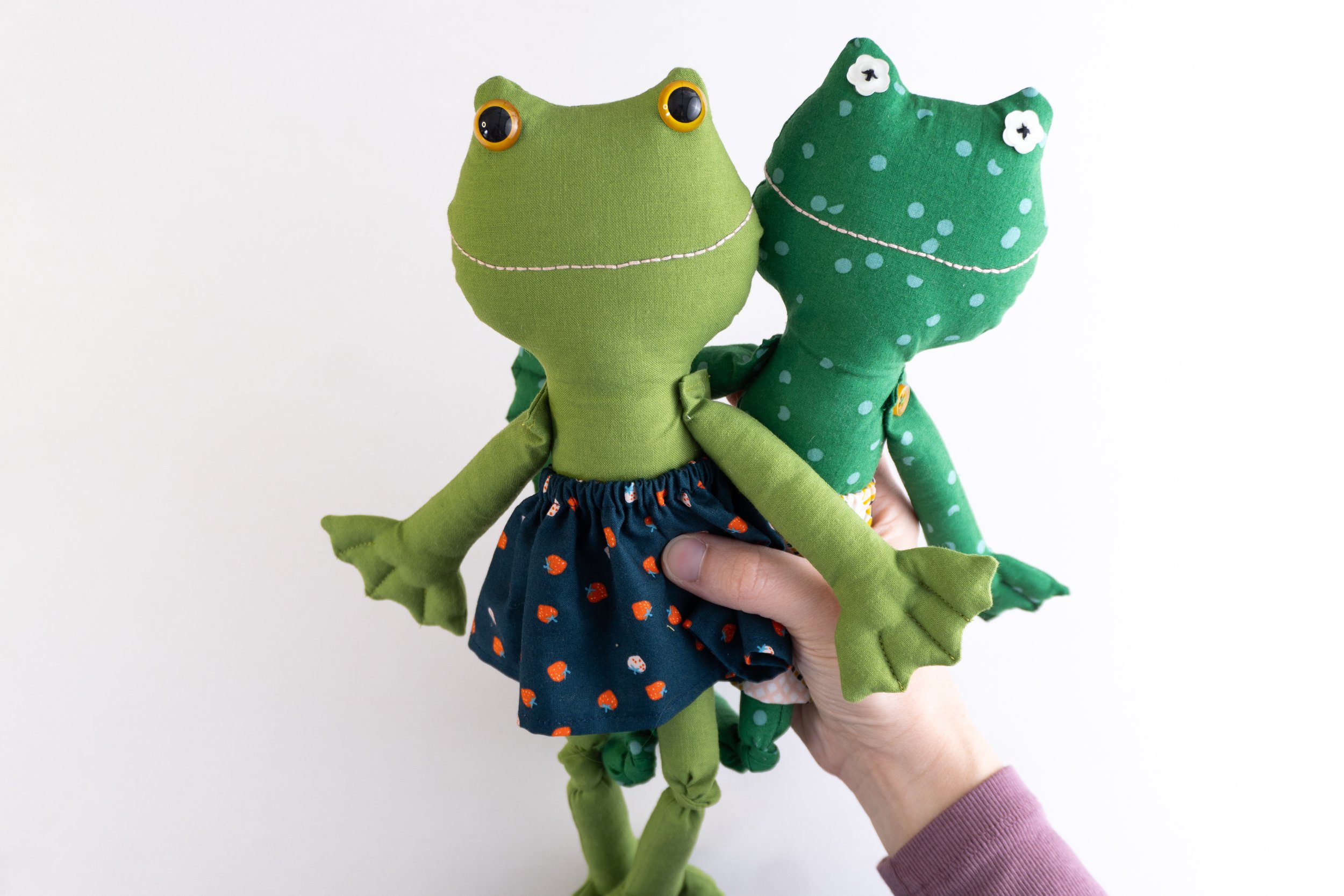Tips for Buying and Using Vintage Sewing Patterns
Last year I scored three boxes full of vintage sewing patterns on Facebook Marketplace for some crazy price, like $10 for the whole lot. I had the best time going through them and picking out what to keep, what was too mouse eaten to touch (ha!) and what to pass along to the next lucky seeker of vintage patterns at a thrift store somewhere.
While I did keep a couple of them just for the great illustrations, I mostly chose to keep the ones that had lines I would actually wear, that were a size that would fit me (or my daughters), and that weren’t redundant with things I already had in my stash.
The real surprise came, though, when I found myself using a few of those vintage patterns and with great success! In fact, I’m at a point now, where I’ll look through those patterns first when seeking a pattern to sew, rather than the modern patterns I also have in my drawer. And now I absolutely wish I would have kept more of the haul!
It’s okay, though, because I know of ways to get my hands on more vintage patterns and I’m going to share that knowledge with you today, along with a handful of tips to make sure you have success when you actually sew with your vintage sewing patterns.
Why I’ve started to prefer vintage patterns
I’ve been trying to sew a few tops for Spring in recent weeks and after two failures with modern patterns from my drawer, I reached into my vintage stash instead. I pulled out a fantastic button down shirt pattern from the 70s and quickly made a muslin. To my shock, this top fit me to absolute perfection on the first try!
The arm holes weren’t gapey, the back didn’t have any pooling fabric, and the waistline was where my actually waist is — all three of these are issues I almost always have when sewing tops with modern patterns. This then reminded me of when I’d used another of my 70’s patterns to make a dress for a 70’s murder mystery party we went to and with equally perfect results. Rarely do I have a modern pattern fit me right out of the envelope these days, but these vintage patterns seem to need few, if any, adjustments.
I can’t really speak to the actual blocks the pattern makers are using and why they design things with more ease and bigger armholes now than they used to in past decades, but if I had to speculate, it would be because they really are trying to fit more bodies, not fewer, (though I’m not sure it’s proving effective). It’s no secret that the averageAmerican body has changed in the last 50 years, so perhaps the pattern companies adapted to that and put more ease into certain pattern pieces around the waistline, in the back, and in the arms. But, I’m just guessing, I really don’t know.
What I do know, is that for me, the vintage pattern blocks seem to fit my body much better than the modern ones, and that is something I’m happy to have discovered. I feel more optimistic about sewing clothing right now than I have in a few years!
Tips for Shopping for Vintage Patterns
My tips here are mainly for shopping in the U.S. and for the Big 4 pattern companies that have been putting out patterns for so many decades. Some of these online options will still be useful for any location, but if you live outside the U.S. and have resources to share for your country, please share those in the comments!
My vintage pattern stash ranges from the 60’s to the 90’s, but the following tips also apply to anything more modern than that, but which may simply be out of print. Also note that patterns earlier than the 50s are obviously more rare, so they can still be found, but be prepared to perhaps search longer and pay more. If you need those patterns, though, you might have more luck getting one of the reprints that the Big 4 pattern companies often release now.
Where to Find Vintage Sewing Patterns
Always check your thrift stores. Many thrift stores bag patterns up in bundles and sell them for a few bucks, or they may have them in the household section, in a box you can sift through. I’ve found many patterns at thrift stores this way and they’re very cheap, usually a dollar or less.
Sites like Craigslist, Offer Up, Freecycle and Facebook Marketplace may be your best bet for getting lots of patterns all at once, and usually for a great price. My stash came from an elderly woman who had been collecting patterns all her life and wanted to offload them easily, so she didn’t charge me and arm and a leg. She was probably also unaware of how desirable these patterns are now, so she didn’t price gauge me.
Other options are Amazon, Etsy, and Ebay. I’m not an Ebay shopper, but I have bought vintage patterns on the other two sites and they are great for when you’re looking for a specific pattern number. The other day I was remembering how much I used to love the Project Runway patterns that Simplicity released in the 2000s and I was able to find many of them to choose from on Amazon. I’ve also seen larger lots of vintage patterns on Etsy too, so that would be a great way to begin building your stash of old patterns.
Ask your grandma. Haha! Really, though, if you have older women in your life, and if your friends have older women in their lives, and word spreads that you sew, make it known that you’re in the market for some vintage patterns and you might just have some magically bestowed upon you!
Reproduced vintage patterns can be found on the Big 4 pattern companies’ websites. It seems Butterick has the most, but you can find these collections at these links: As far as I’ve been able to tell, these patterns have not been altered for the modern body — they are now as they were then! Tools and techniques in the instructions, though, seem to have been updated to include things like fusible interfacing, invisible zippers and other things that weren’t available back when the original patterns were written.
Vintage Patterns and Sizing
Luckily, pattern sizing has not changed and morphed from decade to decade like ready-to-wear clothing sizing has. This may make you feel sad when sewing two sizes bigger than you buy off the rack, haha, but it’s actually really great when you’re using vintage sewing patterns!
When I use a pattern from the 70s, I sew the exact same size I always sew in modern patterns, which I find so nice. I don’t have to figure out an entire new sizing system when making older patterns. This is something the sewing pattern industry has gotten right, even if it’s confusing for those new to sewing who unwittingly make their ready-to-wear size and end up with a garment that’s too small.
Almost all of my vintage patterns from the 80s and earlier come with only one size in the envelope. It was a happy coincidence that the elderly woman who sold me her stash must have had the same measurements as I do, since most of the women’s patterns were in my size. So if you know your size in modern patterns, you know your size in vintage ones! A good rule of thumb is to sew two sizes larger than your store-bought clothing size. So I almost always buy a size 8 in clothing at the store, and I almost always sew a size 12. Then you can adjust from there. I tend to go up a size when making skirts and pants, for example.
While sizing hasn’t changed much, undergarments certainly have! If buying patterns earlier than the 60s, remember that women were still wearing girdles in the 50s. Because of this, and probably because of our generally expanding waistlines and increasingly poor posture, the patterns from those earlier decades were cut much smaller than your waistline probably is today.
Furthermore, bra styles have varied greatly over the decades, and before knit fabrics came on the scene, bust lines were pointier, more separated, and/or more or less emphasized in various ways. All this to say, these are things that do affect the size of the pattern you buy, depending on what decade it was made in. Just go in knowing that adjustments will need to be made.
Sewing with Vintage Patterns
To cut or not to cut — that is the question. There is a lot of debate about this, but … I cut my vintage patterns. Actually, many of mine were cut when I got them, since they had been used and loved by their original owner. But this is the nice thing about patterns that come in only one size! By cutting my size, I’m not cutting off other sizes, as is the case with the graded patterns we buy today. If you want to preserve history, go right ahead and trace off the pieces instead, but here’s permission to cut into these old patterns if you want to.
Always make a muslin. You can read my article all about why and how I make a muslin for every garment I’m going to make, but I’ll summarize by saying that my success rate greatly increased when I stopped being lazy and made test garments before cutting into my nice fabric. I keep old sheets and ugly fabrics around for this purpose so I’m always prepared! Making a mock up of vintage patterns is always a good idea, since like we already discussed, fit and undergarments and other factors have changed over time, so you may have some surprises if you go in blind, and it may cost you some nice fabric.
Understand Fabric Content. This is mainly for patterns made in the 70’s, when polyester began appearing in more and more fashion. Oftentimes, a 70’s pattern will look like its made from a woven fabric on the pattern envelope, but it actually calls for a double knit. When I made my 70’s party dress, I was able to find a polyster knit at a thrift store and made it work. The fabric content is important to know because when something is drafted to be made with a stretch fabric, it will not fit correctly if made with a woven.
Other fabrics, however, can be subbed in for certain other fabrics, like when I used a rayon fabric for the reproduced vintage dress pattern I made my daughter for Easter a few years ago. The pattern was intended to be made with the cottons that were available in the 50s and 60s, and would have had a poofy crinoline underneath. We used a floatier fabric for a less literal effect and it worked perfectly.
Reading vintage patterns is not very different from reading modern patterns, though I feel that they assume a little more sewing knowledge than patterns today do. They’re not necessarily written for beginners, is what I mean by that, but that doesn’t mean you shouldn’t try them if you’re new to garment sewing! Read my series about reading sewing patterns and you will be just fine!
There are a few things I’ve come across that are different in old patterns and fun to note. The top pattern I just made, for example, calls for interfacing and includes instructions for sewing it in! I always use fusible interfacing, along with most people nowadays, of course. So I tend to take the instructions with a grain of salt, since I have my favorite techniques and methods, but I do that with modern patterns too.
Preserving Vintage Patterns
I already admitted that I cut into my vintage patterns. But we can’t deny the coolness factor of some of these vintage patterns and while I do keep mostly patterns in order to actually use them, I kept a few just because the cover artwork was so beautiful! There are some ways to keep these older patterns looking nice, especially if you have uncut ones, or want to use them as artwork.
The most recent pattern I used was already cut and the cover was really falling apart. I like these simple bags for these instances. The pattern fits perfectly inside and I’m not at risk of the envelope disintegrating even more and losing any pieces. The bags are also a good option if you have patterns in pristine condition and want to keep them that way. Comic book sleeves are another idea, though they don’t seal closed.
Framing vintage patterns can be such a fun way to display them as artwork in your sewing room! If you don’t want to spend a lot on framing, comic book frame options are plentiful and many will work for sewing patterns, since they are somewhat similar in size. These are one option and here is another.
Scanning and printing the cover art would also be fun!
I hope this has inspired you to try some vintage patterns that are already in your stash and maybe go on the hunt for some you want to sew! I think the most interesting part for me has been realizing that fashion hasn’t really changed as much as we think it has. I have a wrap skirt pattern from each of at least 4 decades that is the same exact design (the one below was made with a 70’s pattern!) Jacket styles, lingerie, dresses with interesting ties or cut outs — it’s all been done before! And that inspires me to get creative and use my vintage patterns (since they fit me so well) with some modern elements from my modern pattern stash, mixing and matching until I get something truly unique.
Cheers!
Nikki


















